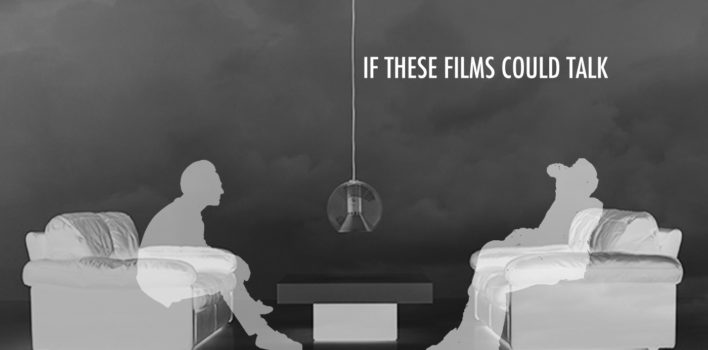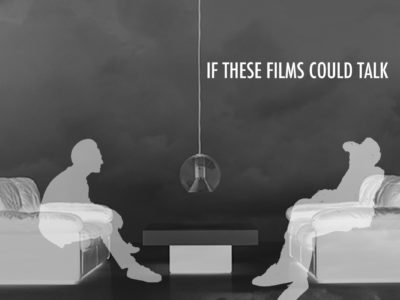Them! (1954) & Indiana Jones and the Kingdom of the Crystal Skull (2008)
“We may be witnesses to a Biblical prophecy come true ― ‘And there shall be destruction and darkness come upon creation, and the beasts shall reign over the earth.’” ― Dr. Harold Medford, Them!
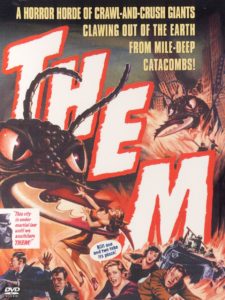 The 1954 horror film Them! from Warner Brothers begins with a mystery. A pair of New Mexico state troopers find a young girl walking alone through the desert holding what’s left of a broken doll. She is mute, apparently from shock, and cannot tell them what happened to her parents whose travel trailer they discover destroyed close by. Down the road, a local store owner is discovered dead in his store, whose one wall has been ripped open, with his shotgun mangled and the only thing missing being sugar. Who, or what, has destroyed the trailer and store, killed at least one person, and left a small, traumatized girl wandering alone in the desert?
The 1954 horror film Them! from Warner Brothers begins with a mystery. A pair of New Mexico state troopers find a young girl walking alone through the desert holding what’s left of a broken doll. She is mute, apparently from shock, and cannot tell them what happened to her parents whose travel trailer they discover destroyed close by. Down the road, a local store owner is discovered dead in his store, whose one wall has been ripped open, with his shotgun mangled and the only thing missing being sugar. Who, or what, has destroyed the trailer and store, killed at least one person, and left a small, traumatized girl wandering alone in the desert?
One of the troopers, Sgt. Ben Peterson (James Whitmore), heads back to headquarters to coordinate with his superiors and find out if the girl is able to communicate yet. His partner remains at the store and the mystery deepens as the horror elements begin to creep in. Hearing a strange sound outside, the trooper goes out to investigate. We hear some gunshots and his screams as the camera remains inside the store.
Back at police headquarters, Sgt. Peterson learns the girl’s parents were traveling on vacation and her father was an FBI agent. An agent from the local Bureau office, Robert Graham (James Arness) has been assigned to the case. Another pair of scientists has been sent from Washington, D.C. as well. Dr. Harold Medford (Edmund Gwenn) and his daughter, Dr. Patricia Medford (Joan Weldon), arrive and finally diagnose the issue. What the area is facing is not some homicidal maniac, but mutated ants. These ants have grown into nine-foot (or longer) giants thanks to radiation exposure from the original nuclear bomb test in New Mexico in 1945.
It should be noted here that the first Godzilla film also debuted the same year as Them!, in 1954. Godzilla would go on to spawn almost 3 dozen films as of this moment and has become part of the great monsters canon. The original Godzilla film was very much birthed out of the same primordial questions as Them!: what mankind has unleashed in the world with the development of nuclear weapons, their aftermath, and capturing the increasing tensions of the Cold War and nuclear arms race. Ishirō Honda, the director and co-writer of Godzilla noted, “If Godzilla had been a dinosaur or some other animal, he would have been killed by just one cannonball. But if he were equal to an atomic bomb, we wouldn’t know what to do. So, I took the characteristics of an atomic bomb and applied them to Godzilla.”
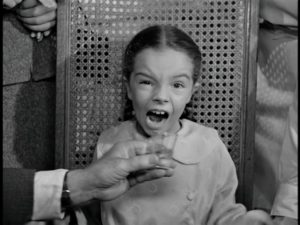 In Them!, however, the ants aren’t a metaphor for the atomic bomb, they are a direct result from the atomic bomb’s use. While most of the film is centered around the immediate need to eradicate the enormous insects, whose capacity for breeding would quickly propel them to the top of the food chain worldwide, the elder Dr. Medford notes, “When man entered the atomic age, he opened a door into a new world. What we’ll eventually find in that new world, nobody can predict.”
In Them!, however, the ants aren’t a metaphor for the atomic bomb, they are a direct result from the atomic bomb’s use. While most of the film is centered around the immediate need to eradicate the enormous insects, whose capacity for breeding would quickly propel them to the top of the food chain worldwide, the elder Dr. Medford notes, “When man entered the atomic age, he opened a door into a new world. What we’ll eventually find in that new world, nobody can predict.”
Also unlike Godzilla, Them! didn’t spawn a host of direct sequels. But it is nonetheless a touchstone of cinematic horror. Originally set to be filmed in color, studio executives at Warner Brothers reduced the film’s budget and it wound up being shot in black and white. Still, the B-movie proved successful and became the top grossing film of the year for the studio. Its cast, from the main characters to bit players, was top notch. James Whitmore would work into the 2000s and is recognizable to present day audiences from appearances in films like The Majestic and The Shawshank Redemption. James Arness would go on to star for 20 seasons in the leading role in Gunsmoke. Edmund Gwenn, nearing the end of his career, had starred as Kris Kringle in the original Miracle on 34th Street. And the supporting cast included Dick York (TV’s Bewitched), Richard Deacon (The Dick Van Dyke Show, Leave it to Beaver), Fess Parker (Daniel Boone), William Schallert (In the Heat of the Night), and a young Leonard Nimoy. The film also helped inspire a sub-genre of Hollywood films, “Atomic Horror,” which included films like Attack of the 50 Foot Woman, Tarantula, and dozens of others, as well as elements that appeared in films like Alien, T2, and, even if indirectly, Indiana Jones and the Kingdom of the Crystal Skull.
‘Now I am become Death, the destroyer of worlds’. ― Dr. Robert Oppenheimer
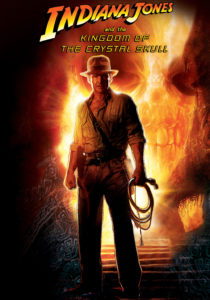 Indiana Jones and the Kingdom of the Crystal Skull opens in the Nevada desert north of Las Vegas in 1957. The film was a mixed-bag attempt from producer George Lucas and director Steven Spielberg to bring Indiana Jones back to the screen, updating the era and the enemies to match the aging Harrison Ford. The very first shot is that of a sandhill. Is it an ant hill? No. It’s a gopher hill. But the idea of sand and building complex tunnels underground is integral to the film.
Indiana Jones and the Kingdom of the Crystal Skull opens in the Nevada desert north of Las Vegas in 1957. The film was a mixed-bag attempt from producer George Lucas and director Steven Spielberg to bring Indiana Jones back to the screen, updating the era and the enemies to match the aging Harrison Ford. The very first shot is that of a sandhill. Is it an ant hill? No. It’s a gopher hill. But the idea of sand and building complex tunnels underground is integral to the film.
Part of the problem in updating Indiana Jones was moving him into a new era ― outside of framing the character in a time period where the Nazis are the enemy. Indiana Jones and the Kingdom of the Crystal Skull places Dr. Jones in a wholly new world, where communists are the enemy and science, or science fiction, is the driving force of the plot instead of the spiritual or mystical that drove the original trilogy.
Jones doesn’t seem phased by his own displacement ― either as an older man, or in a brave new world. He remains true to character ― driven almost instinctively to unravel and solve mysteries before other considerations. In the opening sequence, he assists a Russian infiltration of the infamous Area 51 to recover the remains of an alien who had crashed in Roswell, New Mexico ten years before, only thinking of an escape plan after he’s solved the challenge of how to find the box containing the alien corpse.
The Russians, led by self-proclaimed psychic Irina Spalko (Cate Blanchett, who fails to read Dr. Jones’ mind), flee with the alien cadaver, and Jones escapes not only their clutches, but an atomic bomb test which destroys an eerie simulacrum of a 1950s American small town by entombing himself in a lead-lined refrigerator. This opening sequence serves to reestablish Jones as the character we are familiar with and also place him in a new world. The reaction, both among the audience and critics was mixed, but upon the time of release, mostly negative. The transplacement of Jones into the modern world, full of atomic horrors ― scientific and extraterrestrial ― was jarring.
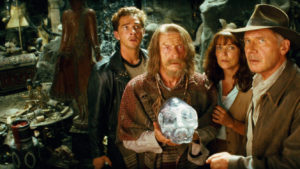 Unshaken, Dr. Jones returns to teaching, but is quickly intertwined with a young, 50s-era greaser, Mutt (Shia LaBeouf), whose mother sent him instructions on how to get ahold of him. Mutt’s mother, and an old acquaintance of Dr. Jones, Professor Oxley (John Hurt), have been taken hostage in South America by the same Russians Dr. Jones has already encountered.
Unshaken, Dr. Jones returns to teaching, but is quickly intertwined with a young, 50s-era greaser, Mutt (Shia LaBeouf), whose mother sent him instructions on how to get ahold of him. Mutt’s mother, and an old acquaintance of Dr. Jones, Professor Oxley (John Hurt), have been taken hostage in South America by the same Russians Dr. Jones has already encountered.
Once Dr. Jones and Mutt arrive in South America and begin to unravel the mystery of what Oxley was looking for and why the Russians have kidnapped him and Mutt’s mother, the film finally begins to take shape. The “golden city” of El Dorado, searched for by Spanish conquistadors and modern archaeologists, exists and was built in part or whole by an alien race. It’s treasure is not gold, but knowledge and psychic power.
Captured again by the Russians, Dr. Jones is reunited with Oxley and Mutt’s mother, Marion Ravenwood (Karen Allen), his companion from Raiders of the Lost Ark. Spalko explains to him her plan ― to harness whatever power is inherent in the Crystal Skull at the place of its origin and wield a power even greater than the atomic bomb. She references the real-world Dr. Oppenheimer, creator of the atomic bomb, noting his inaccurate quote from Hindu scripture, “Now I am become Death, the destroyer of worlds.”
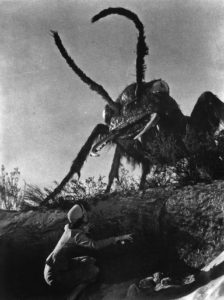 That’s actually a closer translation to the Bhagavad Gita than Dr. Harold Medford’s “Biblical prophecy” from Them!, which cannot be found in any Old Testament prophets or the book of Revelation. Both, however, are referencing the destruction of modern human civilization in response to the atomic bomb. Whereas the elder Dr. Medford seeks to remedy the damage done from mankind’s development of weaponry, Spalko wants to double down and find the next, more powerful, weapon in order for her side to win.
That’s actually a closer translation to the Bhagavad Gita than Dr. Harold Medford’s “Biblical prophecy” from Them!, which cannot be found in any Old Testament prophets or the book of Revelation. Both, however, are referencing the destruction of modern human civilization in response to the atomic bomb. Whereas the elder Dr. Medford seeks to remedy the damage done from mankind’s development of weaponry, Spalko wants to double down and find the next, more powerful, weapon in order for her side to win.
Dr. Jones and his companions escape the clutches of the Russians through a series of unlikely events, culminating in the film’s central set piece, a gun/rapier/fist fight on vehicles through the Amazon jungle. Spielberg’s wit and whimsy are on full display as he incorporates elements of previous films, including the original films’, Tarzan-like swinging through the jungle and sword play, which recalls his earlier work on Hook. The sequence climaxes with all the characters crashing into an ant colony, and Dr. Jones battling Spalko’s chief lieutenant Dovchenko while protected from the deadly, swarming insects by an alien skull (aliens being another Spielberg-ian touchstone) until Dovchenko winds up being gruesomely overwhelmed by them(!) and taken down into the ant colony entrance.
“After the thing went off, after it was a sure thing that America could wipe out a city with just one bomb, a scientist turned to Father and said, ‘Science has now known sin.’ And do you know what Father said? He said, ‘What is sin?’” ― Kurt Vonnegut, Cat’s Cradle
The fear that swept America and the Soviet Union in the century after the Second World War, resulting in the Cold War, was a very real response to a death toll that ranged between 129,000-226,000 after the United States dropped atomic bombs on Hiroshima and Nagasaki, Japan. The fear of new countries gaining the capacity to build nuclear weapons remains to this day. Or of irresponsible leaders using them on a whim. Or terrorists stealing and detonating them among civilian populations.
 Both Them!, a more traditional horror film, and Indiana Jones and the Kingdom of the Crystal Skull attempt to contextualize a world where this destructive power exists. A world where those in power wish to create even more destructive weapons and populations live in fear of “the bomb” or worse going off. It’s a world where miracles and religious powers take a back seat to scientific mysteries and terrors. The sacred writings of the Christian and Hindu religions can only function as prophetic warnings against the secular, scientific age.
Both Them!, a more traditional horror film, and Indiana Jones and the Kingdom of the Crystal Skull attempt to contextualize a world where this destructive power exists. A world where those in power wish to create even more destructive weapons and populations live in fear of “the bomb” or worse going off. It’s a world where miracles and religious powers take a back seat to scientific mysteries and terrors. The sacred writings of the Christian and Hindu religions can only function as prophetic warnings against the secular, scientific age.
It’s notable that sixty years after America deployed the only atomic bombs used in combat to date, Indiana Jones and the Kingdom of the Crystal Skull (and many other contemporary works) refuse to engage in the fallout from the weapon’s effect, instead choosing to focus on what comes next: preparing for the next, more sinister use of the sword. Them!, made a mere decade after the bomb’s deployment is much more interested in questions about the effects its usage portended.
And while both films incorporate the anxieties of the cold war era surrounding the new scientific unknown ― besides the atomic bomb: aliens and UFOs (in Them! a hapless plane pilot can only refer to giant flying queen ants as flying saucers) ― one gets the sense that we as a society haven’t progressed much or grown through our experiences when watching the films back-to-back. We’re not any more willing to wrestle with our use of such a weapon. And even in other ways, such as women’s 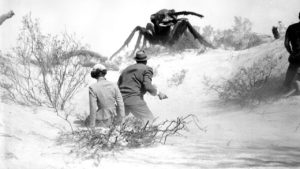 agency and equality, we have possibly regressed. Notably, Dr. Patricia Medford in Them! is given deference and agency by her father, the police, the FBI, and army characters. Whereas in Indiana Jones and the Kingdom of the Crystal Skull, besides one scene where Marion literally takes the wheel, she is met with constant criticism and treated as a foil, more than a partner, to Ford’s Dr. Jones.
agency and equality, we have possibly regressed. Notably, Dr. Patricia Medford in Them! is given deference and agency by her father, the police, the FBI, and army characters. Whereas in Indiana Jones and the Kingdom of the Crystal Skull, besides one scene where Marion literally takes the wheel, she is met with constant criticism and treated as a foil, more than a partner, to Ford’s Dr. Jones.
If Them! and similar “Atomic Horror” films of the time asked us, “How do we deal with the ‘sin’ of the atomic bomb?,” Indiana Jones and the Kingdom of the Crystal Skull (and most of its thematic contemporaries) seem to respond by looking at what our enemies have planned ― inevitably something worse ― and with a shrug, replying, “What sin?”
Darryl A. Armstrong works in marketing and advertising and writes about pop culture. He is the Managing Editor of Rise Up Daily and his work has been featured in Bright Wall/Dark Room, Film Inquiry, and the Arts & Faith Top 100 Films list.


